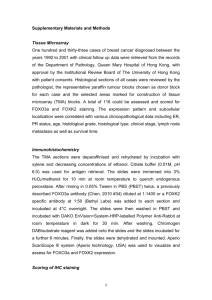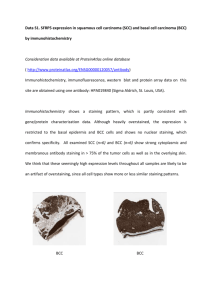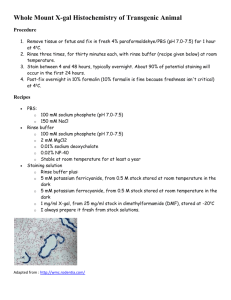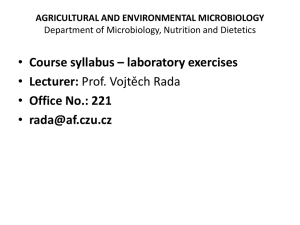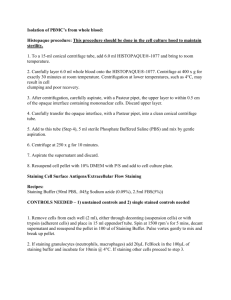Immunofluorescent Staining for Flow Cytometry
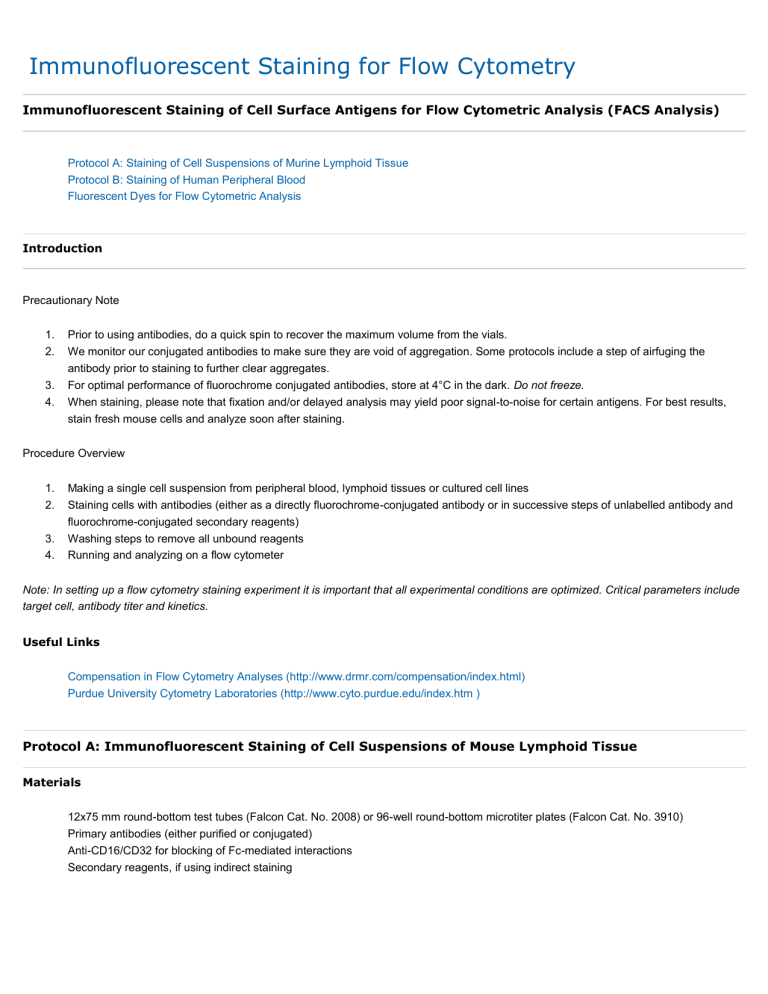
Immunofluorescent Staining for Flow Cytometry
Immunofluorescent Staining of Cell Surface Antigens for Flow Cytometric Analysis (FACS Analysis)
Protocol A: Staining of Cell Suspensions of Murine Lymphoid Tissue
Protocol B: Staining of Human Peripheral Blood
Fluorescent Dyes for Flow Cytometric Analysis
Introduction
Precautionary Note
1. Prior to using antibodies, do a quick spin to recover the maximum volume from the vials.
2. We monitor our conjugated antibodies to make sure they are void of aggregation. Some protocols include a step of airfuging the antibody prior to staining to further clear aggregates.
3.
For optimal performance of fluorochrome conjugated antibodies, store at 4°C in the dark.
Do not freeze.
4. When staining, please note that fixation and/or delayed analysis may yield poor signal-to-noise for certain antigens. For best results, stain fresh mouse cells and analyze soon after staining.
Procedure Overview
1. Making a single cell suspension from peripheral blood, lymphoid tissues or cultured cell lines
2. Staining cells with antibodies (either as a directly fluorochrome-conjugated antibody or in successive steps of unlabelled antibody and fluorochrome-conjugated secondary reagents)
3. Washing steps to remove all unbound reagents
4. Running and analyzing on a flow cytometer
Note: In setting up a flow cytometry staining experiment it is important that all experimental conditions are optimized. Critical parameters include target cell, antibody titer and kinetics.
Useful Links
Compensation in Flow Cytometry Analyses (http://www.drmr.com/compensation/index.html)
Purdue University Cytometry Laboratories (http://www.cyto.purdue.edu/index.htm )
Protocol A: Immunofluorescent Staining of Cell Suspensions of Mouse Lymphoid Tissue
Materials
12x75 mm round-bottom test tubes (Falcon Cat. No. 2008) or 96-well round-bottom microtiter plates (Falcon Cat. No. 3910)
Primary antibodies (either purified or conjugated)
Anti-CD16/CD32 for blocking of Fc-mediated interactions
Secondary reagents, if using indirect staining
[Protocol A: Immunofluorescent Staining of Cell Suspensions of Mouse Lymphoid Tissue -continued]
Buffers eBioscience Flow Cytometry Staining Buffer (Cat. No. 00-4222 )
Sheath fluid for flow cytometer
Instruments
Pipettes and pipettors
Centrifuge
Ice bucket or refrigerator
Flow cytometer
Experiment Duration
1/2 hour cell preparation
1/2 hour antibody dilution and sample preparation
1/2 or 1-1/2 hour incubation depending on the procedure
1/2 hour or longer running and analyzing depending on number of samples
Method
Cell Preparation:
1. Harvest tissue (spleen, lymph nodes, thymus) and tease it apart into single cell suspension by pressing with plunger of a syringe or by mashing between two frosted microscope slides using 10 ml of Staining Buffer.
2. Transfer into a 50ml conical tube and allow the big clumps and debris to settle to the bottom or run the suspension through a nylon mesh (Falcon Cat. No. 2350) to get single cell suspension.
3. Centrifuge cell suspension 4-5 min (300400xg) at 4°C, and discard supernatant.
4. If using spleen, perform an RBC lysis ; otherwise, go to the next step.
5. Resuspend the samples in 50ml of Staining Buffer and perform a cell count and viability analysis (e.g. Trypan Blue).
6. Spin cells again, discard supernatant, and resuspend cells in Staining Buffer at 2x10 7 /ml. If using labeled primary antibodies, preincubate the cells with 0.51µg of anti-CD16/CD32 per million cells for 5-10 minutes on ice prior to staining.
Antibody Preparation and Incubation:
1. Dilute to previouslydetermined optimal concentration of primary antibody in 50µl of Staining Buffer and dispense to each test tube or well of a microtiter plate. Dispense 50µl of Staining Buffer into the unstained or negative control tube. For titration studies, as a general rule, titrations in the range of 2-
0.03µg/million cells should be performed.
2.
Add 50µl of cell suspension (equal to 10 6 cells) to each tube or well; mix gently.
3. Incubate 20 minutes in the dark on an ice bath or in a refrigerator.
Note: Some antibodies may require longer incubation times. Determine these conditions in your preliminary experiments.
4. After the incubation period, add Staining Buffer (2ml for tubes or 200µl for microtiter plates).
5. Centrifuge cells for 5 minutes (300-
400xg) at 4°C. Aspirate supernatant.
6. Repeat 2 times for a total of 3 washes.
7. Resuspend stained cell pellet and analyze samples on a flow cytometer. a. If using fluorochromelabeled antibodies, resuspend stained cell pellet in 500µl of Staining Buffer and run on a flow cytometer. b. If using purified- or biotin-labeled antibodies, add the proper second step (a fluorochrome-conjugated secondary antibody or -
Avidin) in 50100µl of Staining Buffer to each sample. Incubate in the dark for 15-30 minutes on an ice bath or in a refrigerator.
Wash 2 times as above (Steps 4 and 5). Resuspend stained cell pellet in 500µl of Staining Buffer and run on a flow cytometer.
8. For discrimination of viable and dead cells, stain with a viability dye.
Note: If performing multiple color staining, add fluorochrome-labeled antibodies simultaneously and follow incubations and washing steps as mentioned above. Keep all steps in the cold and keep samples protected from light when working with fluorescent antibodies.
Protocol B: Immunofluorescent Staining of Human Peripheral Blood (LWB Procedure)
Materials
12x75 mm test tubes (Falcon Cat. No. 2008)
Primary antibodies (either purified or conjugated)
Secondary reagents, if using indirect staining
Buffers eBioscience Flow Cytometry Staining Buffer (Cat. No. 00-4222 )
Sheath fluid for cytometer eBioscience 1X RBC Lysis Buffer (Cat. No. 00-4333 )
Instruments
Pipettes and pipettors
Centrifuge
Ice bucket or refrigerator
Flow cytometer
Experiment Duration
1/2 hour antibody dilution and sample preparation
1/2 or 1-1/2 hour staining depending on the procedure
1/2 hour or longer running and analyzing depending on number of samples
Method
1. Dilute to previously-determined optimal concentration of purified or biotinconjugated antibody in 50µl of Staining Buffer and dispense to each test tube. Dispense 50µl of Staining Buffer into the unstained or negative control tube. eBioscience fluorochrome-conjugated antihuman antibodies are pretitrated for optimal performance and should be used at 20µl per sample.
2.
Add 100µl of whole blood to each tube, mix gently.
3. Incubate 15-30 minutes at room temperature in the dark. Note: Some antibodies with low affinity binding may require longer incubation times. Determine these conditions in your preliminary experiments.
4. Add 2ml of 1X RBC Lysis Buffer (pre-warmed to room temperature) per tube, mix gently.
5. Incubate samples in the dark at room temperature for 10 minutes. Do not exceed 15 minutes of incubation with the RBC Lysis Buffer.
6. Spin samples (300-400xg) at room temperature, aspirate supernatant and wash 1 time with 2ml of Staining Buffer.
7. Resuspend stained cell pellet and analyze samples on a flow cytometer. a. If using fluorochromelabeled antibodies, resuspend stained cell pellet in 500µl of Staining Buffer or 2% formaldehyde fixation buffer and run on a flow cytometer. b. If using purified- or biotin-labeled antibodies, add the proper second step (a fluorochrome-conjugated secondary antibody or -
Avidin) in 50100µl of Staining Buffer to each sample. Incubate in the dark for 15-30 minutes at room temperature. Wash 1-2 times as above (Step 6). Resusp end stained cell pellet in 500µl of Staining Buffer or 2% formaldehyde fixation buffer and run on a flow cytometer.
Note: If performing multiple-color staining, add antibodies simultaneously and follow incubations and washing steps as mentioned above. Keep samples protected from light when working with fluorochrome-labeled antibodies.
Source: eBioscience, Inc. -- http://www.ebioscience.com/ebioscience/appls/FCS.htm#human


